Documented and Simulated Warm Extremes during the Last 600 Years over Monsoonal China
Abstract
1. Introduction
2. Datasets and Methods
2.1. Datasets
2.1.1. Historical Documents Data
2.1.2. Climate Model Data
2.1.3. Observation Data
2.2. Methods
2.2.1. Warm Records in Chinese Historical Documents
2.2.2. Extreme Temperature Indices
2.2.3. Model Validation
2.2.4. Analyses of Simulated Warm Extremes
3. Results
3.1. Warm Extremes in Historical Documents
3.2. Warm Extremes in Simulations
3.2.1. Changes of Warm Extremes from the LIA to 20C WP
3.2.2. Validation of Indices
3.2.3. Changes of Indices during 1400–2005 CE
4. Discussion and Summary
Supplementary Materials
Author Contributions
Funding
Institutional Review Board Statement
Informed Consent Statement
Data Availability Statement
Acknowledgments
Conflicts of Interest
References
- Matthes, F.E. Report of Committee on Glaciers, April 1939. Trans. Am. Geophys. Union 1939, 20, 518–523. [Google Scholar] [CrossRef]
- Fagan, B.; Grove, J.M. 1988: The Little Ice Age. London: Routledge, xxii + 498 pp. Prog. Phys. Geogr. 2008, 32, 103–106. [Google Scholar] [CrossRef]
- Zhou, X.C.; Jiang, D.B.; Lang, X.M. A multi-model analysis of ‘Little Ice Age’ climate over China. Holocene 2019, 29, 592–605. [Google Scholar] [CrossRef]
- Landrum, L.; Otto-Bliesner, B.L.; Wahl, E.R.; Conley, A.; Lawrence, P.J.; Rosenbloom, N.; Teng, H. Last Millennium Climate and Its Variability in CCSM4. J. Clim. 2013, 26, 1085–1111. [Google Scholar] [CrossRef]
- Xing, P.; Chen, X.; Luo, Y.; Nie, S.; Zhao, Z.; Huang, J.; Wang, S. The Extratropical Northern Hemisphere Temperature Reconstruction during the Last Millennium Based on a Novel Method. PLoS ONE 2016, 11, e0146776. [Google Scholar] [CrossRef]
- Wilson, R.; Anchukaitis, K.; Briffa, K.R.; Büntgen, U.; Cook, E.; D’Arrigo, R.; Davi, N.; Esper, J.; Frank, D.; Gunnarson, B.; et al. Last millennium northern hemisphere summer temperatures from tree rings: Part I: The long term context. Quat. Sci. Rev. 2016, 134, 1–18. [Google Scholar] [CrossRef]
- Bauer, E.; Claussen, M.; Brovkin, V.; Hünerbein, A. Assessing climate forcings of the Earth system for the past millennium. Geophys. Res. Lett. 2003, 30, 1276. [Google Scholar] [CrossRef]
- Luterbacher, J.; Werner, J.P.; Smerdon, J.E.; Fernández-Donado, L.; González-Rouco, F.J.; Barriopedro, D.; Ljungqvist, F.C.; Büntgen, U.; Zorita, E.; Wagner, S.; et al. European summer temperatures since Roman times. Environ. Res. Lett. 2016, 11, 024001. [Google Scholar] [CrossRef]
- Cook, B.I.; Smerdon, J.E.; Seager, R.; Coats, S. Global warming and 21st century drying. Clim. Dyn. 2014, 43, 2607–2627. [Google Scholar] [CrossRef]
- Brunet, M.; Jones, P.D.; Sigró, J.; Saladié, O.; Aguilar, E.; Moberg, A.; Della-Marta, P.M.; Lister, D.; Walther, A.; López, D. Temporal and spatial temperature variability and change over Spain during 1850–2005. J. Geophys. Res. 2007, 112, D12117. [Google Scholar] [CrossRef]
- Pachauri, R.K.; Allen, M.R.; Barros, V.R.; Broome, J.; Cramer, W.; Christ, R.; Church, J.A.; Clarke, L.; Dahe, Q.; Dasgupta, P.; et al. Climate Change 2014: Synthesis Report. Contribution of Working Groups I, II and III to the Fifth Assessment Report of the Intergovernmental Panel on Climate Change; IPCC: Geneva, Switzerland, 2014; p. 151. [Google Scholar]
- Bradley, R.S.; Jonest, P.D. ‘Little Ice Age’ summer temperature variations: Their nature and relevance to recent global warming trends. Holocene 1993, 3, 367–376. [Google Scholar] [CrossRef]
- Cook, E.R.; Krusic, P.J.; Anchukaitis, K.J.; Buckley, B.M.; Nakatsuka, T.; Sano, M.; Members, P.A.K. Tree-ring reconstructed summer temperature anomalies for temperate East Asia since 800 C.E. Clim. Dyn. 2013, 41, 2957–2972. [Google Scholar] [CrossRef]
- Ge, Q.S.; Hao, Z.X.; Zheng, J.Y.; Shao, X.M. Temperature changes over the past 2000 yr in China and comparison with the Northern Hemisphere. Clim. Past 2013, 9, 1153–1160. [Google Scholar] [CrossRef]
- Shi, F.; Yang, B.; Von Gunten, L. Preliminary multiproxy surface air temperature field reconstruction for China over the past millennium. Sci. China Earth Sci. 2012, 55, 2058–2067. [Google Scholar] [CrossRef]
- Svarva, H.L.; Thun, T.; Kirchhefer, A.J.; Nesje, A. Little Ice Age summer temperatures in western Norway from a 700-year tree-ring chronology. Holocene 2018, 28, 1609–1622. [Google Scholar] [CrossRef]
- Yang, B.; Bräuning, A.; Shi, Y.F. Late Holocene temperature fluctuations on the Tibetan Plateau. Quat. Sci. Rev. 2003, 22, 2335–2344. [Google Scholar] [CrossRef]
- Qian, W.H.; Zhu, Y.F. Little Ice Age Climate near Beijing, China, Inferred from Historical and Stalagmite Records. Quat. Res. 2002, 57, 109–119. [Google Scholar] [CrossRef]
- Moberg, A.; Sonechkin, D.M.; Holmgren, K.; Datsenko, N.M.; Karlen, W. Highly variable Northern Hemisphere temperatures reconstructed from low- and high-resolution proxy data. Nature 2005, 433, 613–617. [Google Scholar] [CrossRef]
- Hegerl, G.C.; Brönnimann, S.; Schurer, A.; Cowan, T. The early 20th century warming: Anomalies, causes, and consequences. Wires Clim. Chang. 2018, 9, e522. [Google Scholar] [CrossRef]
- Medhaug, I.; Stolpe, M.B.; Fischer, E.M.; Knutti, R. Reconciling controversies about the ‘global warming hiatus’. Nature 2017, 545, 41–47. [Google Scholar] [CrossRef] [PubMed]
- Smith, D. Has global warming stalled? Nat. Clim. Chang. 2013, 3, 618–619. [Google Scholar] [CrossRef]
- Lavell, A.; Oppenheimer, M.; Diop, C.; Hess, J.; Lempert, R.; Li, J.; Muir-Wood, R.; Myeong, S. Climate change: New dimensions in disaster risk, exposure, vulnerability, and resilience. In A Special Report of Working Groups I and II of the Intergovernmental Panel on Climate Change (IPCC); Field, E.C.B., Barros, V., Stocker, T.F., Qin, D., Dokken, D.J., Ebi, K.L., Eds.; Cambridge University Press: Cambridge, UK; New York, NY, USA, 2012; pp. 25–64. [Google Scholar]
- Diffenbaugh, N.S.; Singh, D.; Mankin, J.S.; Horton, D.E.; Swain, D.L.; Touma, D.; Charland, A.; Liu, Y.; Haugen, M.; Tsiang, M.; et al. Quantifying the influence of global warming on unprecedented extreme climate events. Proc. Natl. Acad. Sci. USA 2017, 114, 4881–4886. [Google Scholar] [CrossRef]
- Easterling, D.R.; Evans, J.L.; Groisman, P.Y.; Karl, T.R.; Kunkel, K.E.; Ambenje, P. Observed Variability and Trends in Extreme Climate Events: A Brief Review. Bull. Am. Meteorol. Soc. 2000, 81, 417–426. [Google Scholar] [CrossRef]
- Scafetta, N. Reconstruction of the Interannual to Millennial Scale Patterns of the Global Surface Temperature. Atmosphere 2021, 12, 147. [Google Scholar] [CrossRef]
- Wyatt, M.G.; Curry, J.A. Role for Eurasian Arctic shelf sea ice in a secularly varying hemispheric climate signal during the 20th century. Clim. Dyn. 2014, 42, 2763–2782. [Google Scholar] [CrossRef]
- Delaygue, G.; Bard, E. An Antarctic view of Beryllium-10 and solar activity for the past millennium. Clim. Dyn. 2011, 36, 2201–2218. [Google Scholar] [CrossRef]
- Gray, L.J.; Beer, J.; Geller, M.; Haigh, J.D.; Lockwood, M.; Matthes, K.; Cubasch, U.; Fleitmann, D.; Harrison, G.; Hood, L.; et al. Solar influences on climate. Rev. Geophys. 2010, 48, RG4001. [Google Scholar] [CrossRef]
- Zhang, D.E.; Demaree, G. Northern China maximum temperature in the summer of 1743: A historical event of burning summer in a relatively warm climate background. Chin. Sci. Bull. 2004, 49, 2508–2514. [Google Scholar] [CrossRef]
- Yang, Y.D.; Man, Z.M.; Zheng, J.Y. A Serious Famine in Yunnan (1815–1817) and the Eruption of Tambola Volcano. Fudan J. 2005, 1, 79–85. [Google Scholar]
- Xiong, W.; Declan, C.; Erda, L.; Yinlong, X.; Hui, J.; Jinhe, J.; Ian, H.; Yan, L. Future cereal production in China: The interaction of climate change, water availability and socio-economic scenarios. Glob. Environ. Chang. 2009, 19, 34–44. [Google Scholar] [CrossRef]
- Patz, J.A.; Campbell-Lendrum, D.; Holloway, T.; Foley, J.A. Impact of regional climate change on human health. Nature 2005, 438, 310–317. [Google Scholar] [CrossRef]
- Tirado, M.C.; Clarke, R.; Jaykus, L.A.; McQuatters-Gollop, A.; Frank, J.M. Climate change and food safety: A review. Food Res. Int. 2010, 43, 1745–1765. [Google Scholar] [CrossRef]
- McMichael, A.J. Insights from past millennia into climatic impacts on human health and survival. Proc. Natl. Acad. Sci. USA 2012, 109, 4730–4737. [Google Scholar] [CrossRef] [PubMed]
- Malhi, Y.; Franklin, J.; Seddon, N.; Solan, M.; Turner, M.G.; Field, C.B.; Knowlton, N. Climate change and ecosystems: Threats, opportunities and solutions. Philos. Trans. R. Soc. B 2020, 375, 20190104. [Google Scholar] [CrossRef]
- Liu, J.; Storch, H.; Chen, X.; Zorita, E.; Zheng, J.Y.; Wang, S.M. Simulated and reconstructed winter temperature in the eastern China during the last millennium. Chin. Sci. Bull. 2005, 50, 2872–2877. [Google Scholar] [CrossRef]
- Peng, Y.B.; Xu, Y.; Jin, L.Y. Climate changes over eastern China during the last millennium in simulations and reconstructions. Quat. Int. 2009, 208, 11–18. [Google Scholar] [CrossRef]
- Xiao, D.; Zhou, X.J.; Zhao, P. Numerical simulation study of temperature change over East China in the past millennium. Sci. China Earth Sci. 2012, 55, 1504–1517. [Google Scholar] [CrossRef]
- Ge, Q.S.; Zheng, J.Y.; Fang, X.Q.; Man, Z.M.; Zhang, X.Q.; Zhang, P.Y.; Wang, W.C. Winter half-year temperature reconstruction for the middle and lower reaches of the Yellow River and Yangtze River, China, during the Past 2000 Years. Holocene 2003, 13, 933–940. [Google Scholar] [CrossRef]
- Zheng, J.Y.; Ge, Q.S.; Hao, Z.X.; Liu, H.L.; Man, Z.M.; Hou, Y.J.; Fang, X.Q. Paleoclimatology proxy recorded in historical documents and method for reconstruction on climate change. Quat. Sci. 2014, 34, 1186–1196. (In Chinese) [Google Scholar]
- Ge, Q.S.; Zheng, J.Y.; Hao, Z.X.; Liu, Y.; Li, M.Q. Recent advances on reonstruction of climate and extreme events in China for the past 2000 yearsc. J. Geogr. Sci. 2016, 26, 827–854. [Google Scholar] [CrossRef]
- Zhang, D.E.; Liang, Y.Y. A study of the severest winter of 1670/1671 over China as an extreme climatic event in history. Clim. Chang. Res. 2017, 13, 25–30. (In Chinese) [Google Scholar]
- Zhang, D.E.; Demaree, G. Extreme warm in the North China summer of 1743: A study of hot historical summer events in a relatively warm climate. Chin. Sci. Bull. 2004, 49, 2204–2210. (In Chinese) [Google Scholar]
- Zheng, J.Y.; Man, Z.M.; Fang, X.Q.; Ge, Q.S. Temperature variation in the eastern China during WEI JIN and South-North Dynasties. Quat. Sci. 2005, 25, 129–140. (In Chinese) [Google Scholar]
- Zhang, D.E. A Collection of Meteorological Records for the Past 3000 Years in China; Phoenix Publishing House: Nanjing, China, 2004. (In Chinese) [Google Scholar]
- Wen, K.G. China’s Meteorological Disasters of China; China Meteorological Press: Beijing, China, 2005. (In Chinese) [Google Scholar]
- Braconnot, P.; Harrison, S.P.; Kageyama, M.; Bartlein, P.J.; Masson-Delmotte, V.; Abe-Ouchi, A.; Otto-Bliesner, B.; Zhao, Y. Evaluation of climate models using palaeoclimatic data. Nat. Clim. Chang. 2012, 2, 417–424. [Google Scholar] [CrossRef]
- Taylor, K.E.; Stouffer, R.J.; Meehl, G.A. An Overview of CMIP5 and the Experiment Design. Bull. Am. Meteorol. Soc. 2012, 93, 485–498. [Google Scholar] [CrossRef]
- Atwood, A.R.; Wu, E.; Frierson, D.M.W.; Battisti, D.S.; Sachs, J.P. Quantifying Climate Forcings and Feedbacks over the Last Millennium in the CMIP5-PMIP3 Models. J. Clim. 2016, 29, 1161–1178. [Google Scholar] [CrossRef]
- Sueyoshi, T.; Ohgaito, R.; Yamamoto, A.; Chikamoto, M.; Hajima, T.; Okajima, H.; Yoshimori, M.; Abe, M.; O’Ishi, R.; Saito, F.; et al. Set-up of the PMIP3 paleoclimate experiments conducted using an Earth system model, MIROC-ESM. Geosci. Model Dev. 2013, 6, 819–836. [Google Scholar] [CrossRef]
- Zhang, W.J.; Jin, F.F. Improvements in the CMIP5 simulations of ENSO-SSTA meridional width. Geophys. Res. Lett. 2012, 39, L23704. [Google Scholar] [CrossRef]
- Ratna, S.B.; Osborn, T.J.; Joshi, M.; Yang, B.; Wang, J. Identifying teleconnections and multidecadal variability of East Asian surface temperature during the last millennium in CMIP5 simulations. Clim. Past 2019, 15, 1825–1844. [Google Scholar] [CrossRef]
- Wu, J.; Gao, X.J. A gridded daily observation dataset over China region and comparison with the other datasets. Chin. J. Geophys. 2013, 56, 1102–1111. (In Chinese) [Google Scholar] [CrossRef]
- Jiang, D.B.; Tian, Z.P.; Lang, X.M. Reliability of climate models for China through the IPCC Third to Fifth Assessment Reports. Int. J. Climatol. 2016, 36, 1114–1133. [Google Scholar] [CrossRef]
- Wu, T.W.; Song, L.; Li, W.; Wang, Z.; Zhang, H.; Xin, X.; Zhang, Y.; Zhang, L.; Li, J.; Wu, F.; et al. An overview of BCC climate system model development and application for climate change studies. J. Meteorol. Res. 2014, 28, 34–56. [Google Scholar] [CrossRef]
- Phipps, S.J.; Rotstayn, L.D.; Gordon, H.B.; Roberts, J.L.; Hirst, A.C.; Budd, W.F. The CSIRO Mk3L climate system model version 1.0—Part 2: Response to external forcings. Geosci. Model Dev. 2012, 5, 649–682. [Google Scholar] [CrossRef]
- Giorgetta, M.A.; Jungclaus, J.; Reick, C.H.; Legutke, S.; Bader, J.; Böttinger, M.; Brovkin, V.; Crueger, T.; Esch, M.; Fieg, K.; et al. Climate and carbon cycle changes from 1850 to 2100 in MPI-ESM simulations for the Coupled Model Intercomparison Project phase 5. J. Adv. Modeling Earth Syst. 2013, 5, 572–597. [Google Scholar] [CrossRef]
- Yukimoto, S.; Adachi, Y.; Hosaka, M.; Sakami, T.; Yoshimura, H.; Hirabara, M.; Tanaka, T.; Shindo, E.; Tsujino, H.; Deushi, M.; et al. A new global climate model of the Meteorological Research Institute: MRI-CGCM3—Model description and basic performance. J. Meteorol. Soc. Jpn. 2012, 90A, 23–64. [Google Scholar] [CrossRef]
- Dufresne, J.L.; Foujols, M.A.; Denvil, S.; Caubel, A.; Marti, O.; Aumont, O.; Balkanski, Y.; Bekki, S.; Bellenger, H.; Benshila, R.; et al. Climate change projections using the IPSL-CM5 Earth System Model: From CMIP3 to CMIP5. Clim. Dyn. 2013, 40, 2123–2165. [Google Scholar] [CrossRef]
- Zhang, X.B.; Alexander, L.; Hegerl, G.C.; Jones, P.; Tank, A.K.; Peterson, T.C.; Trewin, B.; Zwiers, F.W. Indices for monitoring changes in extremes based on daily temperature and precipitation data. Wiley Interdiscip. Rev. Clim. Chang. 2011, 2, 851–870. [Google Scholar] [CrossRef]
- Alexander, L.V.; Zhang, X.; Peterson, T.C.; Caesar, J.; Gleason, B.; Tank, A.M.G.K.; Haylock, M.; Collins, D.; Trewin, B.; Rahimzadeh, F.; et al. Global observed changes in daily climate extremes of temperature and precipitation. J. Geophys. Res. 2006, 111, D05109. [Google Scholar] [CrossRef]
- Zhang, X.B.; Hegerl, G.; Zwiers, F.W.; Kenyon, J. Avoiding inhomogeneity in percentile-based indices of temperature extremes. J. Clim. 2005, 18, 1641–1651. [Google Scholar] [CrossRef]
- Frich, P.; Alexander, L.V.; Della-Marta, P.; Gleason, B.; Haylock, M.; Tank, A.M.G.K.; Peterson, T. Observed coherent changes in climatic extremes during the second half of the twentieth century. Clim. Res. 2002, 19, 193–212. [Google Scholar] [CrossRef]
- Taylor, K.E. Summarizing multiple aspects of model performance in a single diagram. J. Geophys. Res. 2001, 106, 7183–7192. [Google Scholar] [CrossRef]
- Percival, D.B.; Walden, A.T. Wavelet Methods for Time Series Analysis; Cambridge University Press (CUP): Cambridge, UK, 2000. [Google Scholar]
- Smith, L.C.; Turcotte, D.L.; Isacks, B.L. Stream flow characterization and feature detection using a discrete wavelet transform. Hydrol. Process. 1998, 12, 233–249. [Google Scholar] [CrossRef]
- Adepitan, J.O.; Falayi, E.O. Variability changes of some Climatology parameters of Nigeria using wavelet analysis. Sci. Afr. 2018, 2, e00017. [Google Scholar] [CrossRef]
- Yang, F.M.; Wang, N.A.; Shi, F.; Ljungqvist, F.C.; Wang, S.G.; Fan, Z.X.; Lu, J.W. Multi-Proxy Temperature Reconstruction from the West Qinling Mountains, China, for the Past 500 Years. PLoS ONE 2013, 8, e57638. [Google Scholar] [CrossRef]
- Zhang, P.F.; Ren, G.Y.; Xu, Y.; Wang, X.L.; Qin, Y.; Sun, X.B.; Ren, Y.Y. Observed Changes in Extreme Temperature over the Global Land Based on a Newly Developed Station Daily Dataset. J. Clim. 2019, 32, 8489–8509. [Google Scholar] [CrossRef]
- Sen, P.K. Estimates of the Regression Coefficient Based on Kendall’s Tau. J. Am. Stat. Assoc. 1968, 63, 1379–1389. [Google Scholar] [CrossRef]
- Mann, H.B. Nonparametric Tests Against Trend. Econom. Soc. 1945, 13, 245–259. [Google Scholar] [CrossRef]
- Kendall, M.G. Rank Correlation Methods; Charles Griffin: London, UK, 1948. [Google Scholar]
- Ge, Q.S.; Zheng, J.Y.; Fang, X.Q.; Man, Z.M.; Zhang, X.Q.; Zhang, P.Y.; Wang, W.Q. Temperature changes of winter-half-year in eastern China during the past 2000 years. Quat. Sci. 2002, 22, 166–173. (In Chinese) [Google Scholar]
- Hao, Z.X.; Wu, M.W.; Liu, Y.; Zhang, X.Z.; Zheng, J.Y. Multi-scale temperature variations and their regional differences in China during the Medieval Climate Anomaly. J. Geogr. Sci. 2020, 30, 119–130. [Google Scholar] [CrossRef]
- Griffiths, M.L.; Bradley, R.S. Variations of Twentieth-Century Temperature and Precipitation Extreme Indicators in the Northeast United States. J. Clim. 2007, 20, 5401–5417. [Google Scholar] [CrossRef]
- Schmidt, G.A.; Jungclaus, J.H.; Ammann, C.M.; Bard, E.; Braconnot, P.; Crowley, T.J.; Delaygue, G.; Joos, F.; Krivova, N.A.; Muscheler, R.; et al. Climate forcing reconstructions for use in PMIP simulations of the last millennium (v1.0). Geosci. Model Dev. 2011, 4, 33–45. [Google Scholar] [CrossRef]
- Vieira, L.E.A.; Solanki, S.K.; Krivova, N.A.; Usoskin, I. Evolution of the solar irradiance during the Holocene. Astron. Astrophys. 2011, 531, 20. [Google Scholar] [CrossRef]
- Steinhilber, F.; Beer, J.; Fröhlich, C. Total solar irradiance during the Holocene. Geophys. Res. Lett. 2009, 36, L19704. [Google Scholar] [CrossRef]
- Wang, Y.M.; Lean, J.L.; Sheeley, J.N.R. Modeling the Sun’s Magnetic Field and Irradiance since 1713. Astrophys. J. 2005, 625, 522–538. [Google Scholar] [CrossRef]
- Gao, C.C.; Robock, A.; Ammann, C. Volcanic forcing of climate over the past 1500 years: An improved ice core-based index for climate models. J. Geophys. Res. 2008, 113, D23111. [Google Scholar] [CrossRef]
- Crowley, T.J.; Zielinski, G.; Vinther, B.; Udisti, R.; Kreutz, K.; Cole-Dai, J.; Castellano, E. Volcanism and the Little Ice Age. Pages News 2008, 16, 22–23. [Google Scholar] [CrossRef]
- Miao, C.Y.; Duan, Q.Y.; Sun, Q.H.; Huang, Y.; Kong, D.; Yang, T.; Ye, A.; Di, Z.; Gong, W. Assessment of CMIP5 climate models and projected temperature changes over Northern Eurasia. Environ. Res. Lett. 2014, 9, 055007. [Google Scholar] [CrossRef]
- Nam, C.; Bony, S.; Dufresne, J.-L.; Chepfer, H. The ‘too few, too bright’ tropical low-cloud problem in CMIP5 models. Geophys. Res. Lett. 2012, 39, L21801. [Google Scholar] [CrossRef]
- Fyfe, J.C.; von Salzen, K.; Cole, J.N.S.; Gillett, N.P.; Vernier, J.-P. Surface response to stratospheric aerosol changes in a coupled atmosphere–ocean model. Geophys. Res. Lett. 2013, 40, 584–588. [Google Scholar] [CrossRef]
- Christy, J.; Benjamin, H.; Pielke, S.R.; Klotzbach, P.; McNider, R.; Hnilo, J.; Spencer, R.; Chase, T.; David, D. What Do Observational Datasets Say about Modeled Tropospheric Temperature Trends since 1979? Remote Sens. 2010, 2, 2148–2169. [Google Scholar] [CrossRef]
- Zelinka, M.; Klein, S.; Taylor, K.; Andrews, T.; Webb, M.; Gregory, J.; Forster, P. Contributions of Different Cloud Types to Feedbacks and Rapid Adjustments in CMIP5. J. Clim. 2013, 26, 5007–5027. [Google Scholar] [CrossRef]
- Po-Chedley, S.; Armour, K.C.; Bitz, C.M.; Zelinka, M.D.; Santer, B.D.; Fu, Q. Sources of Intermodel Spread in the Lapse Rate and Water Vapor Feedbacks. J. Clim. 2018, 31, 3187–3206. [Google Scholar] [CrossRef]
- Massondelmotte, V.; Schulz, M.; Abeouchi, A.; Beer, J.; Ganopolski, A.; Gonzalez Rouco, J.F.; Jansen, E.; Lambeck, K.; Luterbacher, J.; Naish, T. Chapter 5: Information from Paleoclimate Archives; Cambridge University Press: Cambridge, UK; New York, NY, USA, 2013. [Google Scholar]
- Sun, C.; Jiang, Z.; Li, W.; Hou, Q.; Li, L. Changes in extreme temperature over China when global warming stabilized at 1.5 °C and 2.0 °C. Sci. Rep. 2019, 9, 14982. [Google Scholar] [CrossRef]
- Ding, T.; Yuan, Y.; Zhang, J.M.; Gao, H. 2018: The Hottest Summer in China and Possible Causes. J. Meteorol. Res. 2019, 33, 577–592. [Google Scholar] [CrossRef]
- Dong, X.G.; Zhang, S.T.; Zhou, J.J.; Cao, J.J.; Jiao, L.; Zhang, Z.Y.; Liu, Y. Magnitude and Frequency of Temperature and Precipitation Extremes and the Associated Atmospheric Circulation Patterns in the Yellow River Basin (1960–2017), China. Water 2019, 11, 2334. [Google Scholar] [CrossRef]
- Sun, J.Q. Possible Impact of the Summer North Atlantic Oscillation on Extreme Hot Events in China. Atmos. Ocean. Sci. Lett. 2012, 5, 231–234. [Google Scholar] [CrossRef]
- Hakozaki, M.; Kimura, K.; Tsuji, S.; Suzuki, M. Tree-ring study of a Late Holocene forest buried in the Ubuka Basin, southwestern Japan. IAWA J. 2012, 33, 287–299. [Google Scholar] [CrossRef]
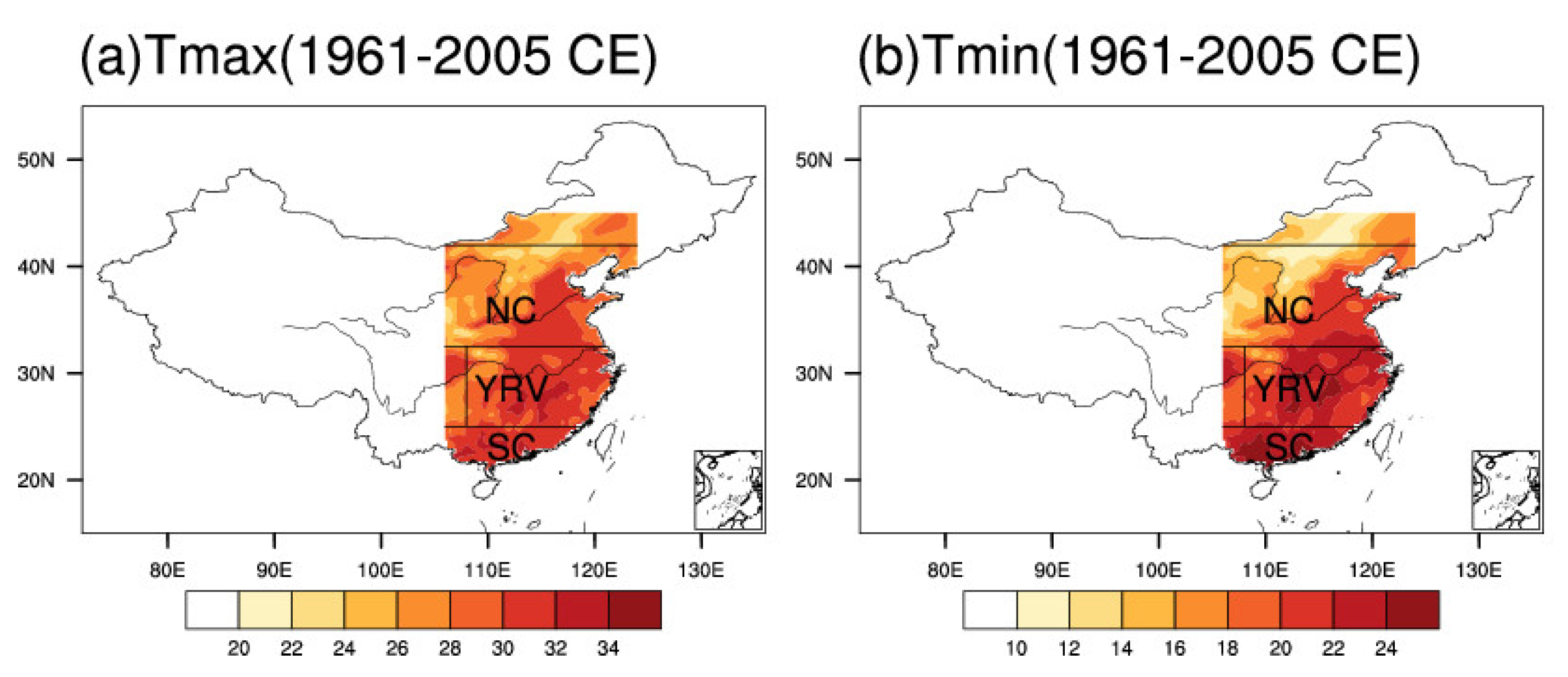
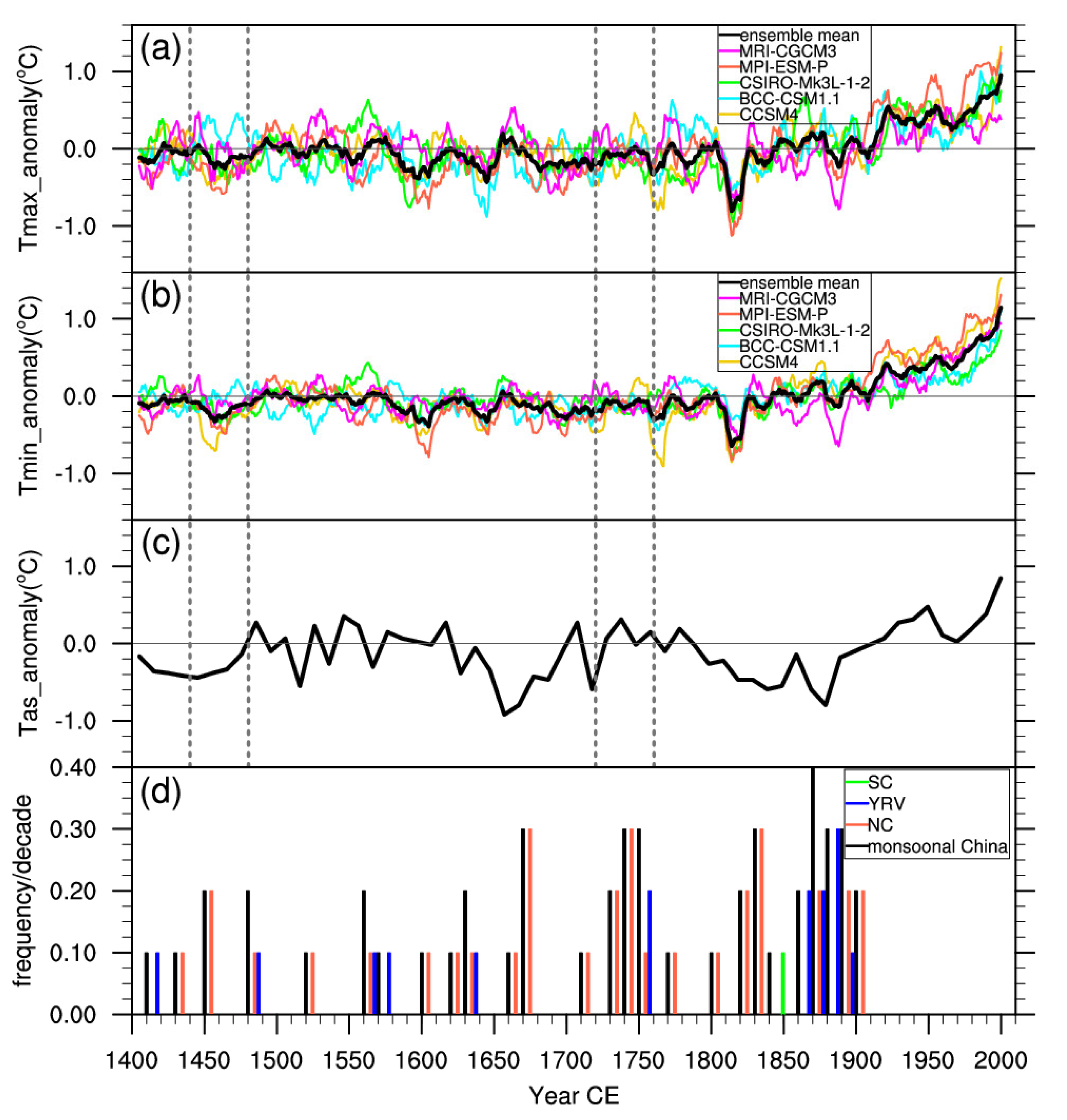
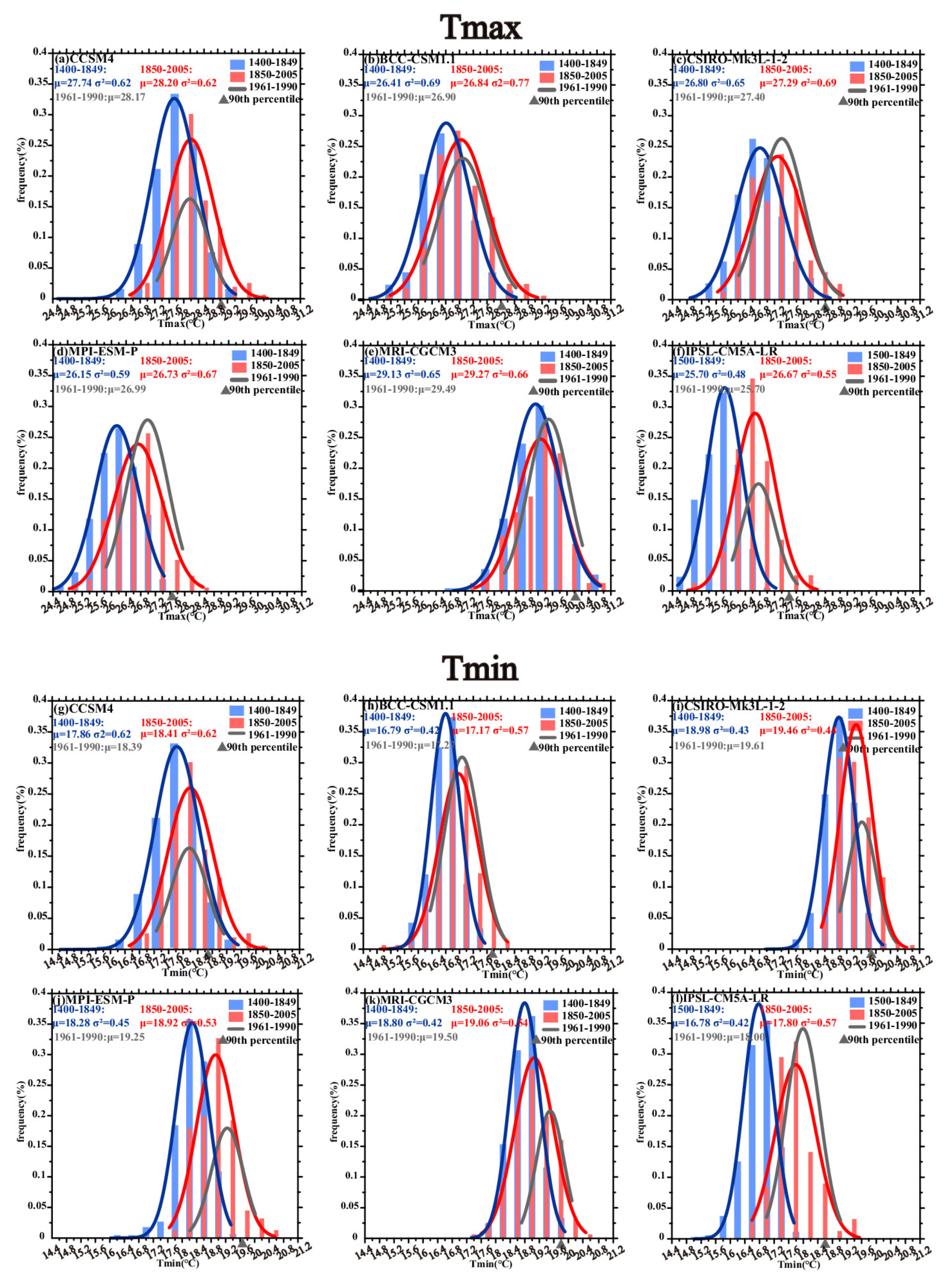
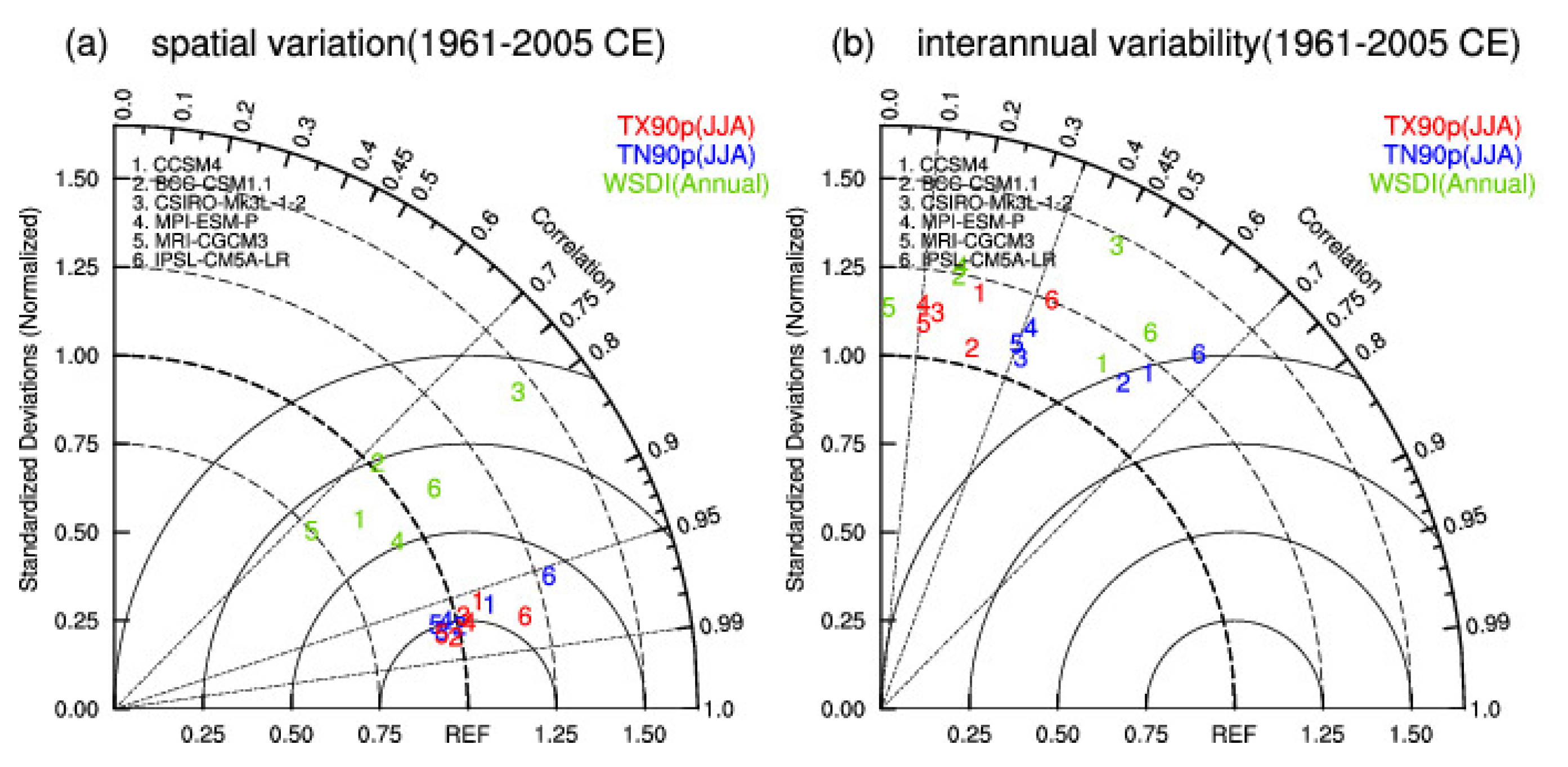
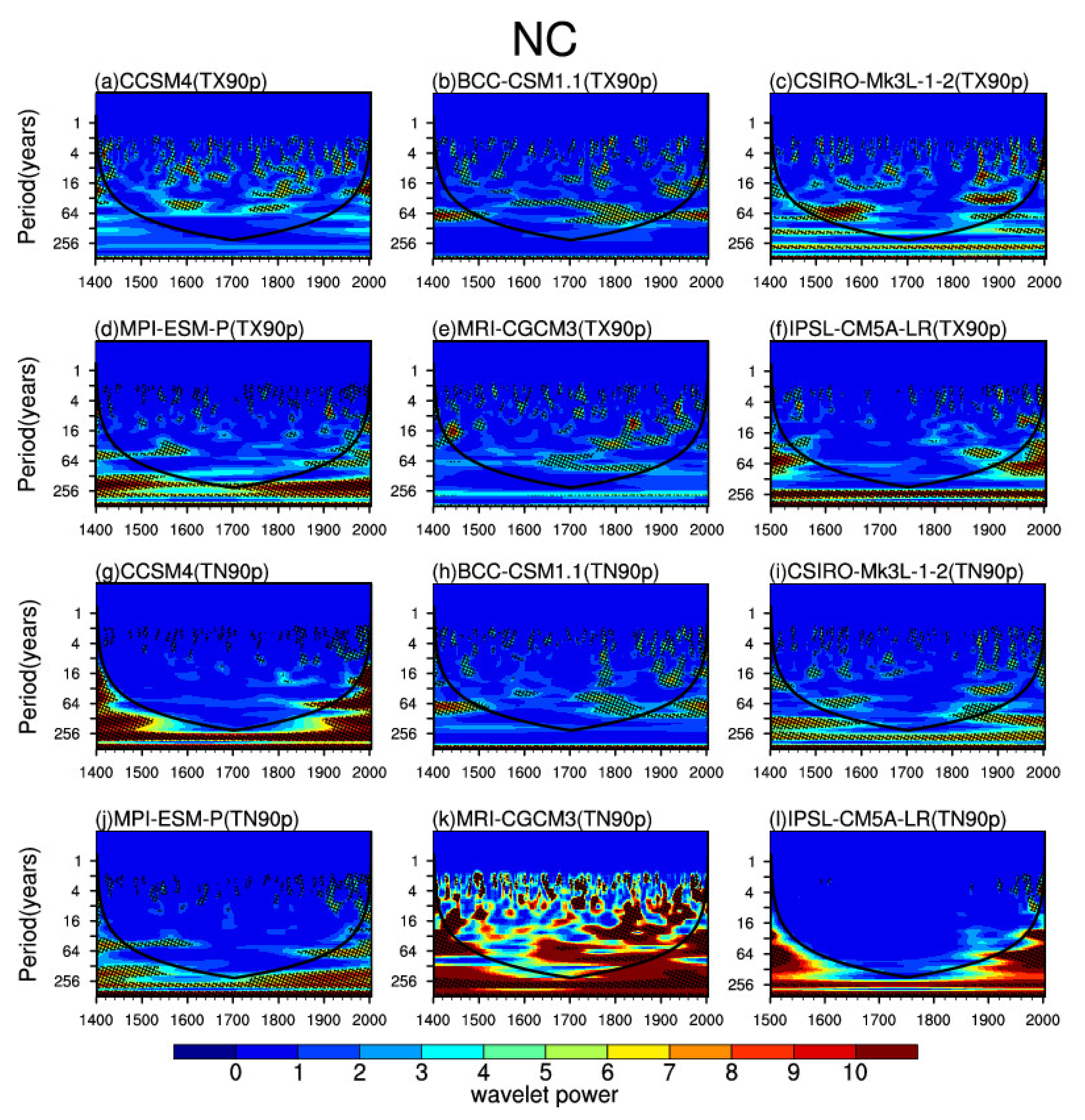
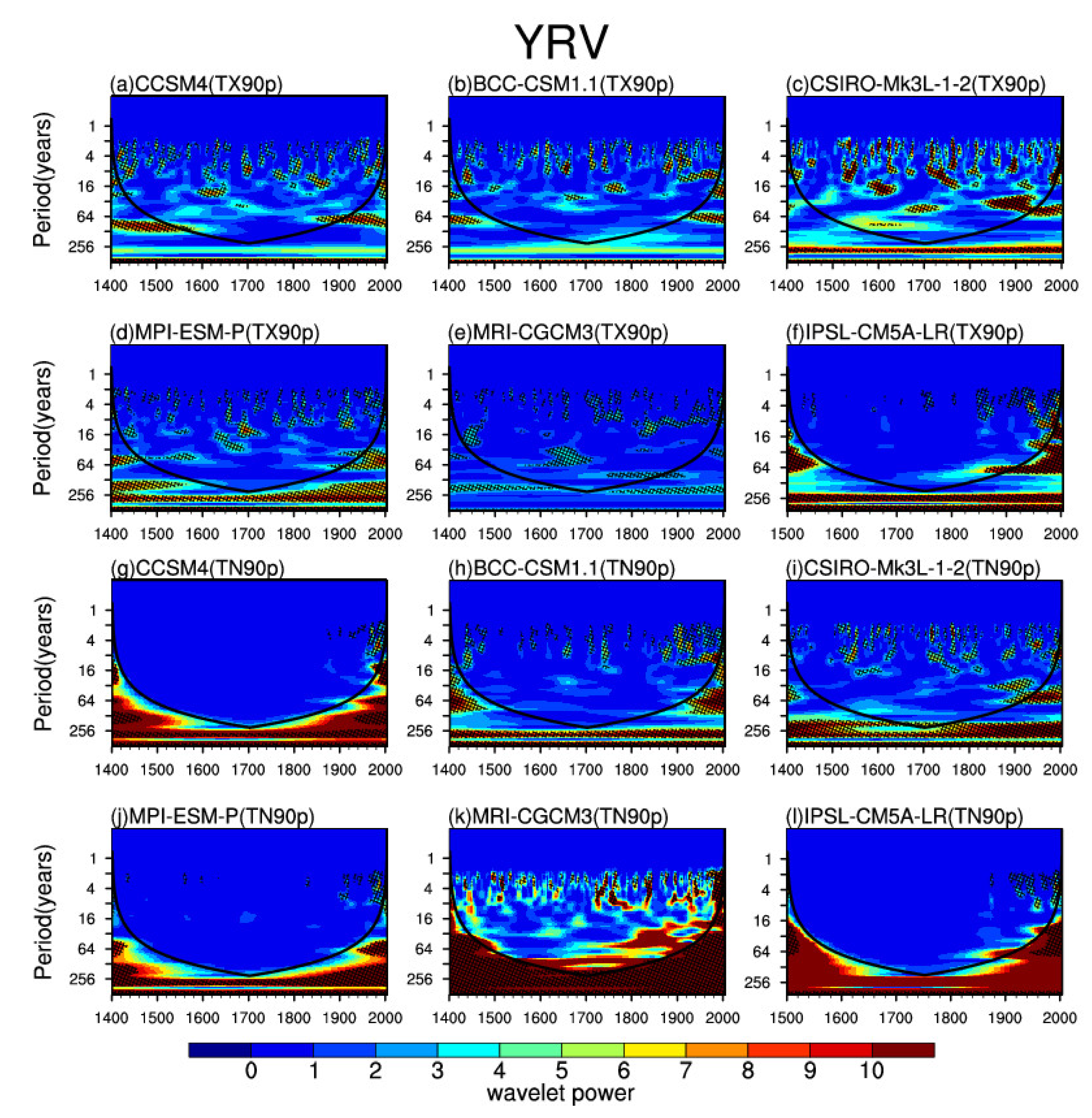
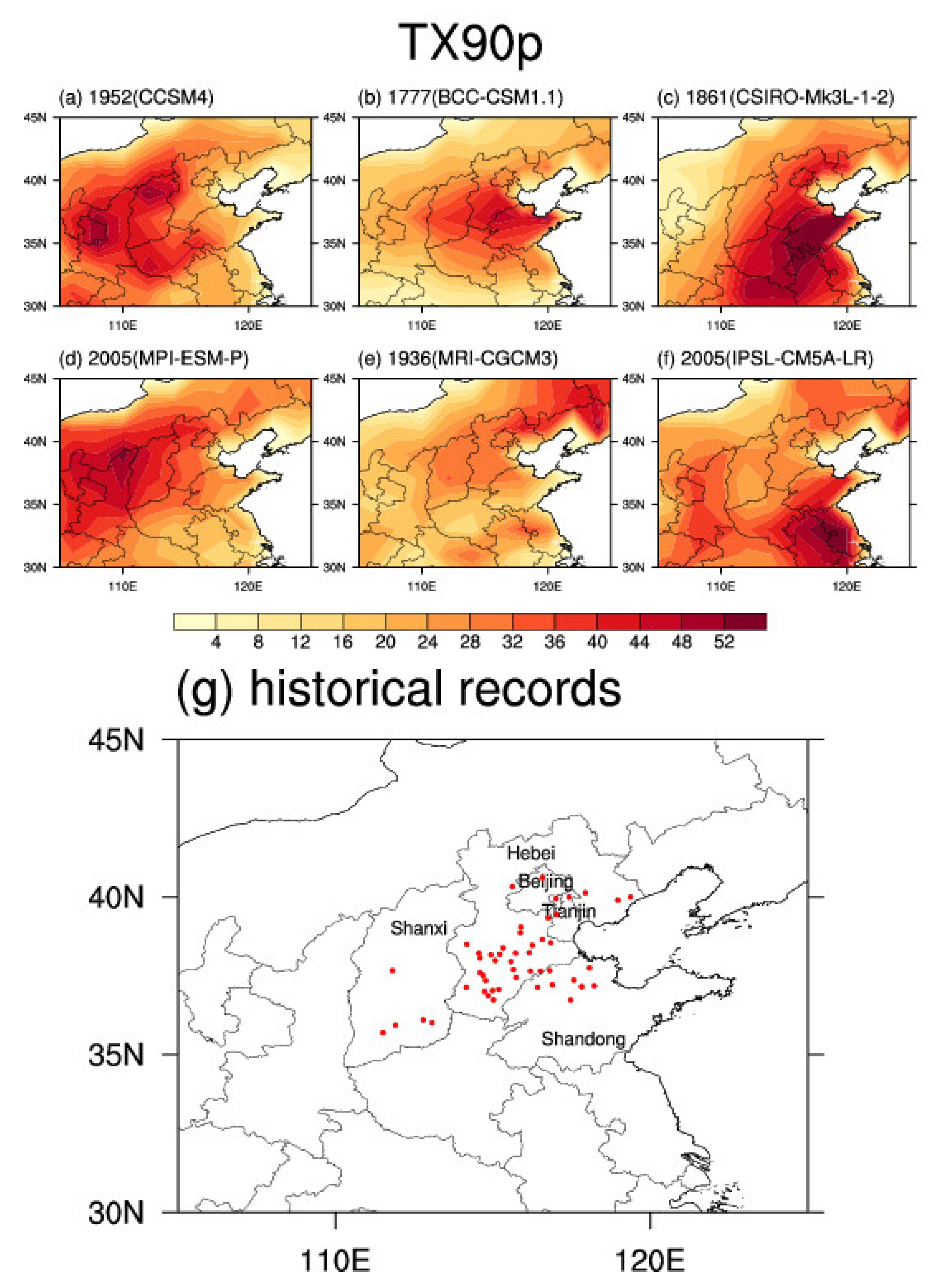
| Institution ID | Data Center and Country | Model * | Atmospheric Resolution | Reference |
|---|---|---|---|---|
| Simulations | ||||
| NCAR | National Center for Atmospheric Research, USA | CCSM4 | 0.94° × 1.25° | [4] |
| BCC | Beijing Climate Center, China Meteorological Administration, China | BCC-CSM1.1 | 2.81° × 2.81° | [56] |
| UNSW | University of New South Wales, Sydney, Australia | CSIRO-Mk3L-1–2 | 3.21° × 5.63° | [57] |
| MPI-M | Max Planck Institute for Meteorology | MPI-ESM-P | 1.88° × 1.88° | [58] |
| MRI | Meteorological Research Institute, Tsukuba, Japan | MRI-CGCM3 | 1.13° × 1.13° | [59] |
| IPSL | Institute Pierre Simon Laplace, Paris, France | IPSL-CM5A-LR | 1.88° × 3.75° | [60] |
| Observation | ||||
| NCC | National Climate Center of the China Meteorological Administration | CN05.1 | 0.25° × 0.25° | [54] |
| Five Decadal Intervals | Years | Region | Number of Records | ||
|---|---|---|---|---|---|
| NC | YRV | SC | |||
| 1400–1449 | 1413 | ✓ | 1 | ||
| 1440 | ✓ | 1 | |||
| 1450–1499 | 1457 | ✓ | 1 | ||
| 1459 | ✓ | 2 | |||
| 1484 | ✓ | 1 | |||
| 1485 | ✓ | 1 | |||
| 1500–1549 | 1525 | ✓ | 1 | ||
| 1550–1599 | 1565 | ✓ | 1 | ||
| 1568 | ✓ | 3 | |||
| 1575 | ✓ | 1 | |||
| 1600–1649 | 1600 | ✓ | 1 | ||
| 1627 | ✓ | 1 | |||
| 1636 | ✓ | ✓ | 5 | ||
| 1650–1699 | 1661 | ✓ | 2 | ||
| 1671 | ✓ | 9 | |||
| 1675 | ✓ | 1 | |||
| 1678 | ✓ | 5 | |||
| 1700–1749 | 1711 | ✓ | 4 | ||
| 1732 | ✓ | 1 | |||
| 1739 | ✓ | 1 | |||
| 1740 | ✓ | 1 | |||
| 1742 | ✓ | 2 | |||
| 1743 | ✓ | 52 | |||
| 1750–1799 | 1752 | ✓ | 1 | ||
| 1753 | ✓ | 1 | |||
| 1759 | ✓ | 1 | |||
| 1773 | ✓ | 1 | |||
| 1800–1849 | 1807 | ✓ | 1 | ||
| 1825 | ✓ | 1 | |||
| 1827 | ✓ | 9 | |||
| 1831 | ✓ | 1 | |||
| 1834 | ✓ | 1 | |||
| 1839 | ✓ | 5 | |||
| 1841 | ✓ | 1 | |||
| 1850–1899 | 1862 | ✓ | 1 | ||
| 1866 | ✓ | 2 | |||
| 1870 | ✓ | 5 | |||
| 1875 | ✓ | ✓ | 4 | ||
| 1877 | ✓ | 3 | |||
| 1887 | ✓ | 1 | |||
| 1888 | ✓ | 1 | |||
| 1889 | ✓ | 1 | |||
| 1893 | ✓ | ✓ | 2 | ||
| 1894 | ✓ | 1 | |||
| 1900–1910 | 1900 | ✓ | 3 | ||
| 1907 | ✓ | 2 | |||
| Model ID | Trend in TX90p (% decade−1) | Trend in TN90p (% decade−1) | ||||||
|---|---|---|---|---|---|---|---|---|
| NC | YRV | NC | YRV | |||||
| 1400–1649 | 1650–2005 | 1400–1849 | 1850–2005 | 1400–1649 | 1650–2005 | 1400–1849 | 1850–2005 | |
| CCSM4 | −0.005 | +0.070 | −0.011 | +0.048 | +0.008 | +0.151 | −0.001 | +0.163 |
| BCC-CSM1.1 | −0.030 | +0.078 | −0.001 | +0.057 | −0.003 | +0.104 | 0 | +0.124 |
| CSIRO-Mk3L-1–2 | −0.010 | +0.083 | −0.005 | +0.058 | +0.024 | +0.108 | −0.003 | +0.110 |
| MPI-ESM-P | −0.006 | +0.122 | −0.002 | +0.143 | −0.014 | +0.143 | +0.001 | +0.171 |
| MRI-CGCM3 | +0.034 | +0.047 | −0.003 | +0.051 | +0.024 | +0.070 | −0.007 | +0.477 |
| IPSL-CM5A-LR | −0.077 | +0.174 | +0.001 | +0.159 | −0.038 | +0.170 | 0 | +0.218 |
Publisher’s Note: MDPI stays neutral with regard to jurisdictional claims in published maps and institutional affiliations. |
© 2021 by the authors. Licensee MDPI, Basel, Switzerland. This article is an open access article distributed under the terms and conditions of the Creative Commons Attribution (CC BY) license (http://creativecommons.org/licenses/by/4.0/).
Share and Cite
Zhou, S.; Tao, L.; Su, Y.; Sui, Y.; Zhang, Z. Documented and Simulated Warm Extremes during the Last 600 Years over Monsoonal China. Atmosphere 2021, 12, 362. https://doi.org/10.3390/atmos12030362
Zhou S, Tao L, Su Y, Sui Y, Zhang Z. Documented and Simulated Warm Extremes during the Last 600 Years over Monsoonal China. Atmosphere. 2021; 12(3):362. https://doi.org/10.3390/atmos12030362
Chicago/Turabian StyleZhou, Shangrong, Le Tao, Yun Su, Yue Sui, and Zhongshi Zhang. 2021. "Documented and Simulated Warm Extremes during the Last 600 Years over Monsoonal China" Atmosphere 12, no. 3: 362. https://doi.org/10.3390/atmos12030362
APA StyleZhou, S., Tao, L., Su, Y., Sui, Y., & Zhang, Z. (2021). Documented and Simulated Warm Extremes during the Last 600 Years over Monsoonal China. Atmosphere, 12(3), 362. https://doi.org/10.3390/atmos12030362






